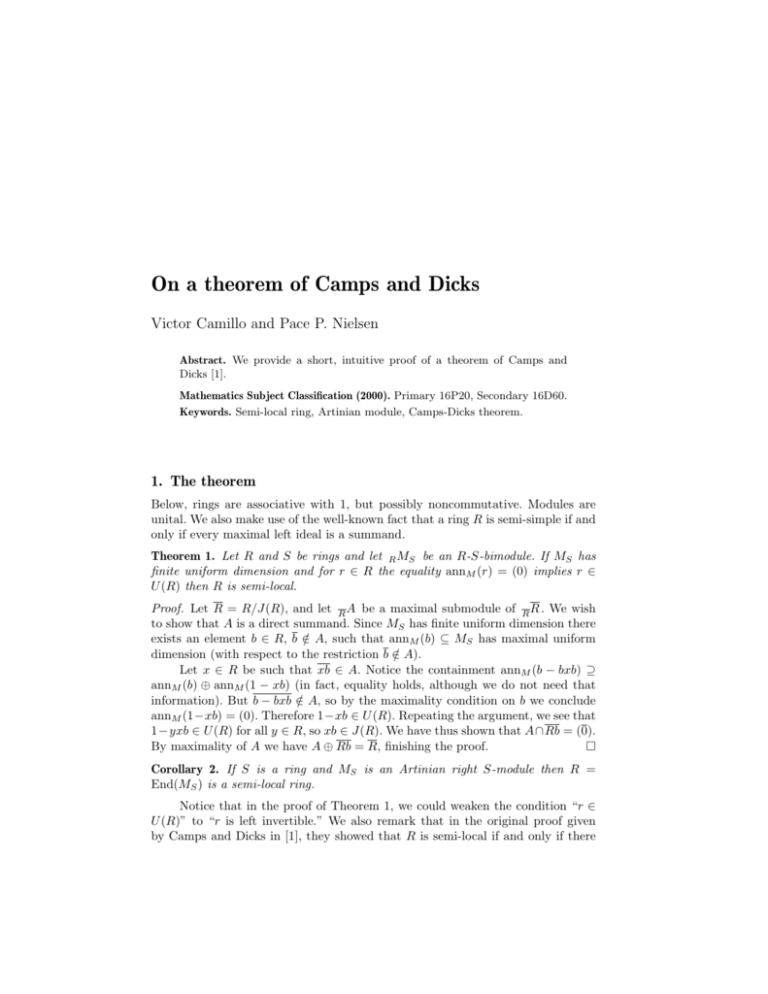On a theorem of Camps and Dicks - BYU Math Dept.
advertisement

On a theorem of Camps and Dicks
Victor Camillo and Pace P. Nielsen
Abstract. We provide a short, intuitive proof of a theorem of Camps and
Dicks [1].
Mathematics Subject Classification (2000). Primary 16P20, Secondary 16D60.
Keywords. Semi-local ring, Artinian module, Camps-Dicks theorem.
1. The theorem
Below, rings are associative with 1, but possibly noncommutative. Modules are
unital. We also make use of the well-known fact that a ring R is semi-simple if and
only if every maximal left ideal is a summand.
Theorem 1. Let R and S be rings and let R MS be an R-S-bimodule. If MS has
finite uniform dimension and for r ∈ R the equality annM (r) = (0) implies r ∈
U (R) then R is semi-local.
Proof. Let R = R/J(R), and let R A be a maximal submodule of R R . We wish
to show that A is a direct summand. Since MS has finite uniform dimension there
exists an element b ∈ R, b ∈
/ A, such that annM (b) ⊆ MS has maximal uniform
dimension (with respect to the restriction b ∈
/ A).
Let x ∈ R be such that xb ∈ A. Notice the containment annM (b − bxb) ⊇
annM (b) ⊕ annM (1 − xb) (in fact, equality holds, although we do not need that
information). But b − bxb ∈
/ A, so by the maximality condition on b we conclude
annM (1−xb) = (0). Therefore 1−xb ∈ U (R). Repeating the argument, we see that
1−yxb ∈ U (R) for all y ∈ R, so xb ∈ J(R). We have thus shown that A∩Rb = (0).
By maximality of A we have A ⊕ Rb = R, finishing the proof.
Corollary 2. If S is a ring and MS is an Artinian right S-module then R =
End(MS ) is a semi-local ring.
Notice that in the proof of Theorem 1, we could weaken the condition “r ∈
U (R)” to “r is left invertible.” We also remark that in the original proof given
by Camps and Dicks in [1], they showed that R is semi-local if and only if there
2
Victor Camillo and Pace P. Nielsen
exists an integer n ≥ 0 and a function d : R → {1, 2, . . . , n} satisfying d(b − bxb) =
d(b) + d(1 − xb), and if d(a) = 0 then a ∈ U (R). One can recover this fact by
letting d(a) denote the composition length of the right annihilator of a ∈ R and
following the ideas in the proof of Theorem 1.
Acknowledgement
This paper was written while the second author was partially supported by the
University of Iowa Department of Mathematics NSF VIGRE grant DMS-0602242.
References
1. Rosa Camps and Warren Dicks, On semilocal rings, Israel J. Math. 81 (1993), no. 1-2,
203–211.
Victor Camillo
Department of Mathematics
University of Iowa
Iowa City, IA 52242
e-mail: camillo@math.uiowa.edu
Pace P. Nielsen
Department of Mathematics
Brigham Young University
Provo, UT 84602
e-mail: pace@math.byu.edu








